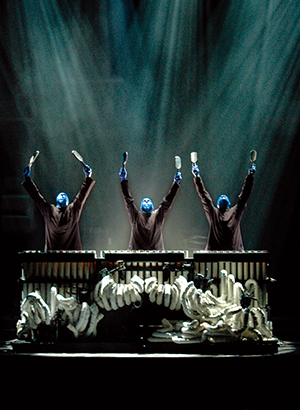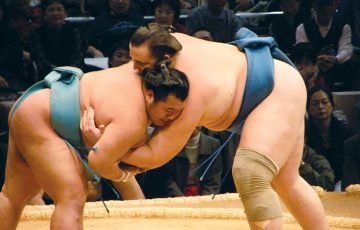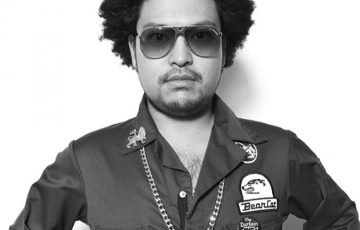 They’re wide-eyed and mute, confused and inquisitive. They’re human but they look different Ð like they’ve come from a distant planet or another dimension altogether. They’re often outrageously funny. They’re righteous drummers. And they’re blue.
They’re wide-eyed and mute, confused and inquisitive. They’re human but they look different Ð like they’ve come from a distant planet or another dimension altogether. They’re often outrageously funny. They’re righteous drummers. And they’re blue.
They are Blue Man Group, a theater/concert experience that has over the past two decades grown into a wildly successful worldwide performance phenomenon.
With its energetic, satirical and family-friendly antics, Blue Man Group marries the oddball, New York artsy sensibility and humor that characterize the best avant-garde performance art with the pounding music and dazzling light show of a rock concert, along with healthy doses of dance, circus-type performance and vaudeville.
Having knocked the socks off local audiences at Summer Sonic back in August, Blue Man Group is back for an open-ended stint at the specially designed Invoice Theatre in Roppongi.
“The concept of the show is that these characters sort of just get dropped into this rock concert experience,” said Jeffrey Turlik, music director of the Tokyo show. “The Blue Men have no prior awareness of what is going on, so it’s up to them to sort out how to function and connect with people, and survive in the moment. And usually they come up with off-the-wall and crazy ways to get through it and bring people together.”
The shows have no actual plot per se. “The back story is a mystery,” he said. “They’re aliens; they don’t speak. But it’s never defined where they come from, whether from Mars or wherever.
“Generally, their aim is to bring the audience together for communal enlightenment, though it’s not just handed to you in such an obvious way,” Turlik said. “By the time they get to the end of the show, everybody realizes we’re all connected now, having gone through this journey together.”
The theater shows change every night as the performers react to the crowd, and the actors are free to improvise. They often interact with the audience to break the “fourth wall” to involve people in the performance. “It really depends on the audience,” Turlik said.
Another running theme is that Blue Man Group takes ordinary everyday objects and does something unique and different with them.
“Blue Man always kind of gets it wrong,” Turlik said, “but it always works out for him in the end.”
But why blue? “Blue is just part of the character,” Turlik said. “There’s no deep reason for it. The original guys just liked the color.”
The color is meant to touch on humankind’s tribal connectedness. It’s also a device to express clearly that they’re outsiders, and help everyone in the audience relate to them. It reflects on the human condition.
“Wherever you go, you feel like an outsider at first and you have to figure out how to fit in,” Turlik mused. “Sometimes it’s difficult, sometimes it’s painful and, often-times, it’s easier to do through humor.”
New York Roots
Blue Man Group was founded in the late 1980s by three friends, Chris Wink, Matt Goldman and Phil Stanton, now referred to as the Founders or, alternatively, ChrisMattPhil. At the time they were in their 20s, sharing a mostly furniture-free apartment in New York, and got the idea to stage a “Funeral for the 80s,” modeled after the Beats’ Funeral for the 50s. So they loaded up a coffin with memorabilia from the 80s (a Rambo doll, a yuppie effigy, and other relevant stuff) and carried it through the streets of New York to Central Park, where they burned coffin and contents in a barrel. An MTV video crew was there to immortalize the event, and the rest is history.
The event led to more street happenings, then appearances in theaters, incorporating a backing band, bizarre instruments and other avant-garde elements. The shows gradually gained a following, and grew to become what it is now Ð a hugely popular performance phenomenon.
The group currently runs semi-permanent sit-down shows in eight cities, starting in New York, then Boston, Chicago, Las Vegas, Berlin, Orlando, Florida and Oberhausen, Germany. And, now, Tokyo.
They also have a touring rock show that has done the US circuit twice, and is now making the rounds of South America Ð Argentina, Mexico, Brazil and Chile so far.
Supporting these shows is a large and growing organization. From its start as three guys with a loose and shifting entourage of punks, hipsters, artists, musicians and assorted hangers-on, the group has grown into a company nearly 2,000-strong.
Each venue requires 100 or more staff Ð Blue Men, musicians, roadies and support crew Ð so with 10 shows and a tour, that means about 1,200 Blue Man Group personnel doing the gigs at any given time, plus office staff. They play from six to 14 shows a week, depending on the situation and demand. The Tokyo venue will stage seven shows a week.
The shows here are pure Blue Man, but they have been localized a bit to appeal a little better to Japanese audiences and make use of locally available props, Turlik said. “There are some cultural things we can’t avoid. For example, some of the pieces use food, but you can’t get some of the foods here that we usually use. Like you can’t get Cheerios or Cap’n Crunch here, so we had to find another crunchy cereal for Blue Man to make music with.”
Turlik appeared excited by the Tokyo venue. “It’s exciting, playing here,” he said. “Blue Man Group has always been influenced by Japanese culture, technology and science, and it’s fun to come here and play around with that.”
How To Become A Blue Man
 Regular people become Blue Men via auditions, although the group’s casting calls are, needless to say, somewhat different from the usual audition for a musical or theater production. “It’s not your regular Shakespearian-type role,” Turlik noted. “You need to have musical skill, be able to communicate without speaking through your eyes and facial expressions. And you have to be able to catch things in your mouth.”
Regular people become Blue Men via auditions, although the group’s casting calls are, needless to say, somewhat different from the usual audition for a musical or theater production. “It’s not your regular Shakespearian-type role,” Turlik noted. “You need to have musical skill, be able to communicate without speaking through your eyes and facial expressions. And you have to be able to catch things in your mouth.”
The ideal Blue Man candidate is a six-foot tall drummer who possesses very expressive eyes and looks good bald. It helps if they look good blue, too. Prospective candidates should be in fairly good shape Ð it’s a physically demanding job and the Blue Men tend to bulk up quite a bit as they get into playing the role regularly. Age, ethnicity and skin color (obviously) are not factors, nor is gender Ð there has been a woman, “a female Blue Man, not a Blue Woman,” Turlik was quick to clarify for us. The youngest was 19.
The Invoice Theater, the stage built in Roppongi for the group’s ongoing stint here, has, like most Blue Man Group venues, been designed to accommodate the group’s special needs. “For example, there’s a lot of mess at a Blue Man show, and the first few rows, where audience members can expect to be doused in water, food, paint and whatever else the Blue Men decide to experiment with, is known as the poncho section,’ where everybody is issued plastic ponchos at the beginning of the show,” Turlik said.
“For the same reason, we like to be able to hose down the theater after each show, so we need drains Ð something most theaters don’t have.”
“Some of our shows use giant prop pieces, like in Las Vegas we bring in a Cessna jet plane for one number, and you need to build a pretty big space that can accommodate that,” he said.
One of the hallmarks of a Blue Man Group performance is the unusual instruments the Blue Men play, most of them designed in-house at the group’s headquarters in New York. For example, the group’s iconic Drum Bone is assembled from some big PVC tubes that Blue Man discovers lying around on the stage and start drumming with, fitting and sliding them together to create musical tones like a huge percussive trombone.
They play other oddball contraptions, including the generically named PVC Instrument, a device with a tangle of PVC tubes that spill out of it like plastic viscera. The Tubulum, another PVC pipe-based bass instrument with a sound like a deep-range synthesizer, is perfect for playing covers of synthesizer-heavy songs such as Donna Summers’ “I Feel Love.”
The Backpack Tubulum is another huge percussion instrument, which the Blue Men wear like a huge PVC sousaphone (it’s featured in the group’s famous rendition of The Who’s “Baba O’Riley”).
The group also uses Airpoles, fiberglass tubes, some stretching as long as six meters, which make a weird and satisfying “whoosh” when they’re whipped through the air.
Other instruments used in the Blue Man shows include the Piano Smasher, a sound board and strings from a grand piano that is hit with a mallet, and the Dumpstulum, which consists of two steel garbage dumpsters lying on their sides, and is played by having five musicians rhythmicallyThey also use conventional instruments. Some shows have a backing rock band, which uses the standard rock instrumentation of guitar, bass and drums; others feature unusual instruments, such as the Chapman Stick and the Cimbalom, a Hungarian hammer dulcimer-like instrument that the Blue Men play with drumsticks.
All of the instruments are strictly analog, though some, such as the Piano Smasher, often need a little MIDI (that is, computer) assistance, as they quickly go out of tune.
When Blue Men Go Grey
 The Founders have largely retired from active performing (it’s a young man’s game and they’re all well into their 40s), but the phenomenal success of Blue Man Group has led the organization to branch out into other projects.
The Founders have largely retired from active performing (it’s a young man’s game and they’re all well into their 40s), but the phenomenal success of Blue Man Group has led the organization to branch out into other projects.
Over the past 15 years, the group has done TV commercials (including a famous Intel spot in 1995), appeared on TV shows, and music videos, scored films and videos, and released four albums of Blue Man songs, three of which Ð “audio,” “The Complex” and “I Feel Love” Ð have been gold-sellers; a fourth, “Live at the Venetian,” was recently released on iTunes. The title track of “The Complex” was featured in the closing credits of Terminator 3: Rise of the Machines.
They also enthusiastically collaborate with other musicians, many of whom also appear in their shows Ð Dave Matthews, violinist Tracy Bonham and Gavin Rossdale of the British band Bush, to name a few. The group recently collaborated with Dave Stewart (formerly of the Eurythmics) to score the upcoming animated film, Space Chimps.
The Founders also started a school for children two years ago in New York, a learning center focused on creativity.
But wherever the Founders decide to take the group next, crowd-pleasing showmanship married with avant-garde sensibility and lots of humor, plus an openness to change and innovation are what keep Blue Man Group packing ‘em in around the world.
“That’s what keeps it fun for those of us who work for Blue Man,” Turlik said. “There’s always something new and exciting. We’re genre-busting. It’s getting harder and harder to pinpoint what we are. Besides fun.”
Story by Robert Cameron
From J SELECT Magazine, December 2007















Recent Comments